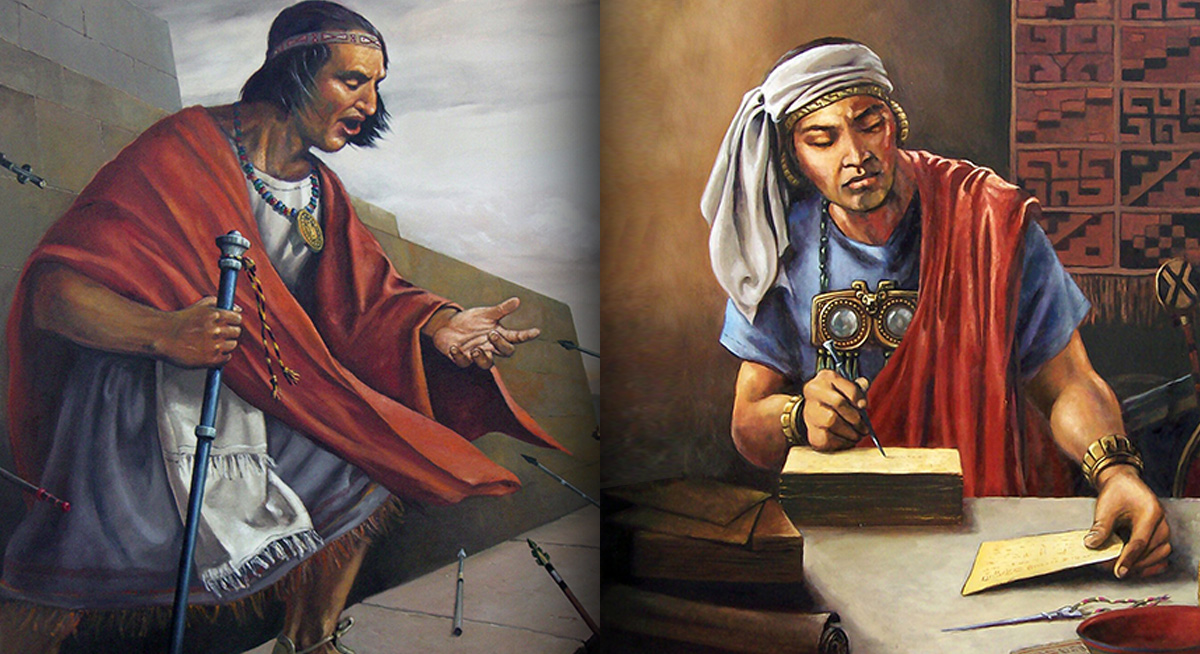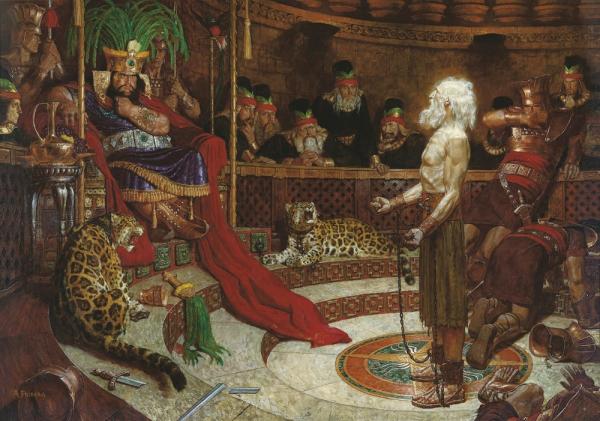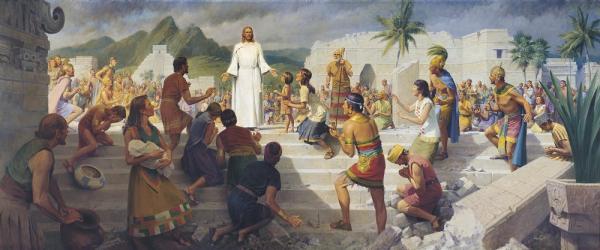
The Know
John W. Welch has described the Book of Mormon as
prophetic in every sense of the word. It is written by prophets and about prophets. It was foreseen by prophets and foresees our day. It is a book brought forth by prophetic gifts for prophetic purposes. It speaks forth in a clarion voice of warning with words of counsel to those who would survive the last days.1
On some level or another, most readers notice these recurring prophetic themes throughout the text. What may not be so apparent is that some of the Book of Mormon’s major narratives seem to have been designed specifically to emphasize the fulfillment of its prophetic declarations. When this pattern is recognized, it becomes clear that prophecy plays a fundamental rather than incidental role in shaping the structure and content of the Book of Mormon. The following summaries offer only a brief sampling of important prophetic fulfillments in the text. Many additional examples are highlighted in a chart provided in the appendix.
Nephi’s Prophecies
The prophet Nephi shaped much of his first book based on a prophecy given to him by the Lord when his family first left Jerusalem. The Lord declared that “inasmuch as thy brethren shall rebel against thee, they shall be cut off from the presence of the Lord, And inasmuch as thou shalt keep my commandments, thou shalt be made a ruler and a teacher over thy brethren” (1 Nephi 2:22). Over and over again, Nephi recorded the rebellion of his brothers, and his own efforts to teach and instruct them.2 After Lehi’s group reached the promised land, Nephi made sure to report that the Lord’s prophecy had been fulfilled (see 2 Nephi 5:19).
Nephi also recorded visions about his future descendants, including their wars, the Savior’s ministry among them, their generations of peace, and their ultimate destruction (see 1 Nephi 12). In addition, Nephi summarized Zenos’s prophecies about the physical catastrophes that would occur at the time of Christ’s death (1 Nephi 19:10–16). When Mormon was searching among the Nephite records, he discovered these prophecies in Nephi’s set of small plates. Because they contained “the prophecies of the coming of Christ,” Mormon found them to be valuable and included them in his own record (see Words of Mormon 1:4).
What readers may not realize is how important Nephi’s writings were in shaping the rest of Mormon’s abridgment. According to Steven L. Olsen, “Nephi’s prophecies became so crucial to [Mormon’s] literary purpose that he consciously structured a major portion of his narrative in order to document their literal and complete fulfillment.”3 Olsen suggested that Mormon did this “in order to draw attention to the close correspondence between prophecy and scriptural history.”4
Abinadi’s Prophecies
During Abinadi’s trial before King Noah and his priests, Abinadi made a number of prophetic declarations that Mormon made sure to record in detail.5 For instance, Abinadi predicted that the Nephites “shall be brought into bondage, and shall be smitten on the cheek” (Mosiah 12:2). Mormon then recorded two exodus stories, the first involving the people of Limhi (Mosiah 19–22) and the second following the converts who followed Alma (Mosiah 23–24). It’s notable that the major obstacle in each story is that the people came into bondage, just as Abinadi prophesied.
Samuel’s Prophecies
The prophecies given by Samuel the Lamanite, which themselves relied heavily upon the words of past prophets,6 played an important role during the years immediately preceding Christ’s second coming. Not only did Samuel’s prophecies provide very specific signs of Christ’s death, but they also gave a specific time and sign of His birth.7 A disputation about the timing of Samuel’s prophecy provides the major narrative in 3 Nephi 1. Then, in 3 Nephi 8–10, Mormon repeatedly highlighted the fulfillment of the signs of Christ’s death. Samuel’s prophecies were so important to the Nephite historical record that Jesus Himself made sure that their fulfillment was accurately recorded (see 3 Nephi 23:9).
The Why
These and many other fulfilled prophecies provide subtle yet intriguing evidence of the Book of Mormon’s impressive complexity and consistency.8 Most people don’t notice how integral prophecies are to the Book of Mormon’s structure and content. It’s something that typically must be discerned through careful study. It should also be recognized that the book’s precise prophetic fulfillments are scattered throughout its pages and are often separated from the prophecies themselves by large amounts of text.
This suggests that whoever produced the text of the Book of Mormon either knew the Nephite history very intimately or worked from some sort of outline or notes to keep track of its numerous prophecies and their fulfillments.9 Yet, according to eyewitnesses, Joseph Smith dictated the text in a remarkably short amount time without relying on any outlines, notes, or reference materials.10 With this in mind, the Book of Mormon’s fulfilled prophecies provide good evidence that its words were intentionally crafted by Mormon and Moroni and were then miraculously revealed to the prophet Joseph Smith.
Indeed, Mormon’s statements repeatedly show that he was conscious of these prophecies and their fulfillment. On one occasion he remarked, “And the power of the evil one was wrought upon all the face of the land, even unto the fulfilling of all the words of Abinadi, and also Samuel the Lamanite” (Mormon 1:19). On another occasion he noted that when the people were on the brink of destruction they “began to remember the prophecies of Alma, and also the words of Mosiah” (Helaman 4:21). Likewise, Moroni reported that the Jaredite destruction transpired according to “the words which had been spoken by the mouth of all the prophets” and that they had been “fulfilled thus far, every whit” (Ether 15:3).
As readers pay careful attention to the details in each Book of Mormon story, they will see how over and over again the words of the prophets came to pass. Recognizing this pattern can build trust that its prophecies about our own day will likewise be fulfilled. Mormon declared, “I … know that as many things as have been prophesied concerning us down to this day have been fulfilled, and as many as go beyond this day must surely come to pass.” (Words of Mormon 1:4; emphasis added)
We can also learn much from the way that different groups in the Book of Mormon treated the sacred prophecies given to them by the Lord. Those who refused to heed prophetic warnings often suffered sorrow and destruction.11 In contrast, others experienced peace and joy as they looked towards the fulfillment of prophecy “with great earnestness” (3 Nephi 8:3). In one period of especially harsh persecution, the Lord comforted His people by declaring, “Lift up your head and be of good cheer; for … on the morrow come I into the world, to show unto the world that I will fulfil all that which I have caused to be spoken by the mouth of my holy prophets” (3 Nephi 1:13; emphasis added).
Faithful people today can likewise look forward to Christ’s second coming with great earnestness, fully expecting that He will fulfill all of the prophecies about our own day, “yea, all things, every whit, according to the words of the prophets” (3 Nephi 1:20). After recounting the Savior’s ministry among the Nephites in the October session of general conference in 2004, Elder Robert D. Hales taught,
Brothers and sisters, the prophecies of Christ’s first coming were fulfilled, “every whit.” As a result, many throughout the world believe that the Savior did come and did live in the meridian of time. But there are still many prophecies yet to be fulfilled! In this and other conferences, we hear living prophets prophesy and testify of Christ’s Second Coming. They also witness of the signs and wonders all about us, telling us that Christ will surely come again. Are we choosing to believe their words?12
The Book of Mormon invites us to not only believe its prophecies about our day, but to also trust the prophets in our own day.13 If we do, we will have both peace and protection in what will surely be turbulent times. And we can look forward with faith and hope for the millennial era of peace that will follow the return of the Savior.
Further Reading
Steven L. Olsen, “Prophecy and History: Structuring the Abridgment of the Nephite Records,” Journal of Book of Mormon Studies 15, no. 1 (2006): 18–29, 70–71.
Melvin J. Thorne, “Complexity, Consistency, Ignorance, and Probabilities,” in Book of Mormon Authorship Revisited: The Evidence for Ancient Origins, ed. Noel B. Reynolds (Provo, UT: FARMS, 1997), 179–193.
John W. Welch, “Textual Consistency,” in Reexploring the Book of Mormon: A Decade of New Research, ed. John W. Welch (Salt Lake City and Provo, UT: Deseret Book and FARMS, 1992), 21–23.
Appendix
Fulfilled Book of Mormon Prophecies |
||
|
Topic |
Prophecy |
Fulfillment |
|---|---|---|
|
Jerusalem Will Be Destroyed |
||
|
Lehi’s Family Will Be Led to a Land of Promise |
|
|
|
Lehi’s Posterity Will Prosper or Be Cursed |
|
|
|
Nephi’s Brothers Will Be Cut Off |
||
|
Nephi Will Be a Ruler and Teacher |
||
|
Laman and Lemuel Will Be Cursed |
||
|
Lamanites Will Be a Scourge14 |
||
|
Lord Will Deliver Lehi’s Sons and Destroy Laban |
||
|
Zoram Will Have a Place among Lehi’s People |
||
|
Brass Plates Will Be Preserved |
|
|
|
Christ Will Come 600 Years after Lehi Left Jerusalem |
||
|
Nephites Will Become a Civilization with Many Cities |
||
|
Mists of Darkness Will Be on the Land |
||
|
Lightnings Will Be on the Land |
3 Nephi 8:7, 12, 17, 19 |
|
|
Thunder Will Be on the Land |
3 Nephi 8:6, 12, 17, 19 |
|
|
Earthquakes Will Be on the Land |
3 Nephi 8:12, 17, 19 |
|
|
Tumultuous Noises Will Be Heard |
||
|
Rocks and Earth Will Be Rent |
||
|
Mountains Will Tumble and Be Laid Low |
||
|
Plains and Earth Will Be Broken Up |
||
|
Cities Will Be Sunken |
||
|
Cities Will Be Burned |
||
|
Cities Will Be Shaken and Tumble |
||
|
Vapor of Darkness Will Be Removed |
||
|
Righteous Will Be Preserved from Destruction |
||
|
Heavens Will Open |
||
|
Lamb of God Will Descend |
||
|
Lamb of God Will Show Himself |
||
|
Holy Ghost Will Fall on Twelve Disciples |
||
|
Twelve Disciples Will Be Chosen and Ordained |
||
|
Twelve Disciples Will Judge the Nephites |
|
|
|
Righteous Generations Will Precede Final Destruction |
||
|
Destruction Will Follow Fourth Generation |
|
|
|
Lamanites will Overcome Nephites |
||
|
Nephite/Lamanite Mixture Won’t Be Utterly Destroyed |
||
|
Lamanites Won’t Be Utterly Destroyed |
||
|
Nephites Will Record Christ’s Words |
||
|
Lord Will Visit the Righteous with His Voice |
||
|
Lord Will Visit the Wicked with Tempests |
||
|
Earth Will Open |
||
|
Mountains Will Be Carried Up |
||
|
Earth Will Groan |
||
|
Travelers to the Promised Land Must Be Led by the Lord |
||
|
Curse upon Lamanites Will Be Removed |
||
|
God Will Mark Lamanites to Make Them Unenticing |
||
|
Nephites Who Mix with Lamanites Will Be Cursed |
||
|
Mosaic Law Will Be Fulfilled and Its Ordinances Will End |
|
|
|
Signs Will Be Given of Christ’s Birth |
||
|
Signs Will Be Given of Christ’s Death |
||
|
Wicked Will Perish for Stoning, Slaying, and Casting out Prophets |
||
|
Blood of Saints Will Cry from the Ground |
||
|
Depths of the Earth Will Swallow the Wicked |
||
|
Mountains Will Cover the Wicked |
||
|
Whirlwinds Will Carry Away the Wicked |
|
|
|
Buildings Will Fall and Crush the Wicked |
|
|
|
Despite Persecution, Righteous Saints Will Steadfastly Look for the Signs of Christ’s Coming |
||
|
Christ Will Heal the People |
||
|
Christ’s Ministry Will Be Followed by Generations of Peace |
||
|
Spirit Will Cease to Strive with the Nephites |
||
|
Nephites Will Be Speedily Destroyed |
||
|
Lord Will Lead Away the Righteous |
||
|
Wicked Nephites Will Become Weak Like unto Their Brethren |
||
|
Repentance Will Bring Deliverance from Bondage |
||
|
Nephites Will Be Put into Bondage |
||
|
Only the Lord Will Deliver the Nephites from Bondage |
||
|
Lord Will Be Slow to Hear Cries |
||
|
Nephites Will Be Smitten |
|
|
|
Nephites Will Be Driven |
||
|
Beasts Will Devour Flesh |
||
|
King Noah Will Suffer Death by Fire |
||
|
Nephites Will Be Smitten with Famine and Pestilence |
|
|
|
Burdens Will Be Placed on Backs |
||
|
Nephites Will Be Driven As a “Dumb Ass” |
||
|
Nephites Will Be Utterly Destroyed |
||
|
Descendants of Noah’s Priests Will Kill Believers with Fire |
||
|
Descendants of Noah’s Priests Will Be Smitten, Driven, and Scattered |
||
|
Descendants of Noah’s Priests Will Be Hunted |
||
|
Many Will Repent and Believe the Sons of Mosiah |
||
|
Lord Will Deliver the Sons of Mosiah |
||
|
People Will Be Destroyed when the Majority Become Wicked |
||
|
Lord Will Utterly Destroy Ammonihah |
||
|
Ammonihah Will Be Destroyed in One Day |
||
|
Sons of Mosiah Will Need to Be Patient in Afflictions |
|
|
|
Sons of Mosiah Will Be Instruments in God’s Hands |
|
|
|
Lord Will Preserve the People of Ammon |
|
|
|
Nephites Will Be Destroyed 400 Years after Christ’s Ministry |
|
|
|
Nephites Will Be Trodden Down If They Become Wicked |
|
|
|
Helaman’s Army Will Be Delivered |
||
|
Cities Will Be Taken Away |
|
|
|
Chief Judge Will Be Murdered |
||
|
Judge Will Be Lying in His Own Blood |
||
|
Nephi Will Smite Earth with Famine, Pestilence, and Destruction |
|
|
|
Zarahelma Will Be Destroyed with Fire |
||
|
Lord Will Curse Riches |
||
|
People Will Attempt to Hide Riches When Fleeing from Enemies |
||
|
People Will Persecute, Stone, and Cast Out Prophets |
||
|
Treasures Will Become “Slippery” |
||
|
People Will Cry unto the Lord Because of Their Lost Riches |
||
|
Destruction Will Be Made Sure when the Day of Probation Is Past |
|
|
|
People Will Weep and Howl and Lament |
||
|
People Will Cry, Wishing They Had Repented Before Destruction |
||
|
Demons Will Afflict the People |
||
|
Christ Will Be Born in Five Years15 |
||
|
Night without Darkness Will Be a Sign of Christ’s Birth |
||
|
New Star Will Be a Sign of Christ’s birth |
||
|
Many Signs and Wonders Will Be in Heaven |
||
|
People Will Be Amazed |
||
|
People Will Fall to the Earth |
||
|
Calamities Will Be a Sign of Christ’s Death |
|
|
|
There Will Be Three Days of Darkness |
||
|
No Light Will Shine from Moon or Stars |
||
|
Calamities Will Last for Hours |
||
|
Rocks Will Be Rent in Twain |
|
|
|
Earth Will Be Broken in Fragments, Seams, and Cracks |
|
|
|
Highways Will Be Broken Up |
||
|
Cities and Houses Will Be Left Desolate |
|
|
|
Graves Will Be Opened and Saints Will Arise from the Dead |
||
|
Saints Will Appear to Many |
||
|
Signs and Wonders Will Be in the “Whole Earth” and upon “All the Face of the Land” |
||
|
Women Who Can’t Flee Will Perish |
||
|
Curse Will Be on the Land |
||
|
Jaredites Will Be Destroyed |
||
|
Bones Will be Left after Destruction |
||
|
Coriantumr Will Survive the Destruction of His People |
||
- 1. Hugh Nibley, The Prophetic Book of Mormon (Salt Lake City and Provo, UT: Deseret Book and FARMS, 1989), vii. It should be noted that Welch was trying, in his own words, to capture Hugh Nibley’s vision and understanding of the Book of Mormon’s prophetic nature.
- 2. See Book of Mormon Central, “Why Was It Significant that Nephi Was Made ‘a Ruler and a Teacher’ Over His Brethren? (1 Nephi 2:22),” KnoWhy 462 (August 28, 2018). The importance of Nephi’s status as a ruler held political significance for his posterity for generations. See Noel B. Reynolds, “Nephi’s Political Testament,” in Rediscovering the Book of Mormon: Insights You May Have Missed Before, ed. John L. Sorenson and Melvin J. Thorne (Salt Lake City, UT: Deseret Book, 1991), 221. See also, Noel B. Reynolds, “The Political Dimension in Nephi’s Small Plates,” BYU Studies Quarterly 27, no. 4 (1987): 15–37. For specific stories that foreshadowed Nephi’s status as a ruler and a teacher, see Book of Mormon Central, “Why Was the Sword of Laban So Important to Nephite Leaders? (Words of Mormon 1:13),” KnoWhy 411 (February 27, 2018); Book of Mormon Central, “Why Did Nephi Include the Story of the Broken Bow? (1 Nephi 16:23),” KnoWhy 421 (April 3, 2018).
- 3. Steven L. Olsen, “Prophecy and History: Structuring the Abridgment of the Nephite Records,” Journal of Book of Mormon Studies 15, no. 1 (2006): 28.
- 4. Olsen, “Prophecy and History,” 28.
- 5. For a short treatment of these prophecies, see Grant Hardy, Understanding the Book of Mormon: A Reader’s Guide (New York: NY: Oxford University Press, 2010), 112–113. It seems likely that these prophecies were given in the context of a Pentecost celebration. See Book of Mormon Central, “Did Abinadi Prophesy During Pentecost? (Mosiah 13:5),” KnoWhy 90 (May 2, 2016).
- 6. See Book of Mormon Central, “Why did Samuel Rely So Heavily on the Words of Past Prophets? (Helaman 14:1),” KnoWhy 185 (September 12, 2016); Shon Hopkin and John Hilton III, “Samuel’s Reliance on Biblical Language,” Journal of Book of Mormon Studies 24 (2015): 31–52; John W. Welch, “Textual Consistency,” in Reexploring the Book of Mormon: A Decade of New Research, ed. John W. Welch (Salt Lake City and Provo, UT: Deseret Book and FARMS, 1992), 21–23; Quinten Barney, “Samuel the Lamanite, Christ, and Zenos: A Study of Intertextuality,” Interpreter: A Journal of Mormon Scripture 18 (2016): 159–70. For analysis of Samuel’s prophetic language, see Donald W. Parry, “‘Thus Saith the Lord’: Prophetic Language in Samuel’s Speech,” Journal of Book of Mormon Studies 1, no. 1 (1992): 181–183; S. Kent Brown, “The Prophetic Laments of Samuel the Lamanite,” in From Jerusalem to Zarahemla: Literary and Historical Studies of the Book of Mormon (Provo, UT: Religious Studies Center, 1998), 163–180.
- 7. See Book of Mormon Central, “Why Did Samuel Make Such Chronologically Precise Prophecies? (Helaman 13:5),” KnoWhy 184 (September 9, 2016).
- 8. See Melvin J. Thorne, “Complexity, Consistency, Ignorance, and Probabilities,” in Book of Mormon Authorship Revisited: The Evidence for Ancient Origins (Provo, UT: FARMS, 1997), 179–193; Book of Mormon Central, “Evidence of the Book of Mormon: Internal Complexity,” online at bookofmormoncentral.org.
- 9. For further evidence that an outline was likely used, see Brant A. Gardner, “Mormon’s Editorial Method and Meta-Message,” FARMS Review 21, no. 1 (2009): 84–87.
- 10. See Book of Mormon Central, “Why Did the Book of Mormon Come Forth as a Miracle? (2 Nephi 27:23),” KnoWhy 273 (February 10, 2017).
- 11. For example, the people of Ammonihah refused to believe that their city could be destroyed in a single day, but Mormon reported that this is exactly what happened (see Alma 9:4–5; cf. Alma 16:10).
- 12. Robert D. Hales, “Finding Faith in the Lord Jesus Christ,” Ensign, November 2004, online at lds.org.
- 13. For instance, see 2 Nephi 3:6–14.
- 14. The scriptures in the “Fulfillment” column were derived from John W. Welch and Gregory J. Welch, Charting the Book of Mormon: Visual Aids for Personal Study (Provo, UT: FARMS, 1999), 136.
- 15. For a possible solution to the apparent discrepancy in Samuel’s five-year prophecy, see Neal Rappleye, “‘The Time is Past’: A Note on Samuel’s Five-Year Prophecy,” Interpreter: A Journal of Mormon Scripture 29 (2018): 21–30.
Continue reading at the original source →






